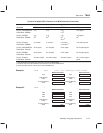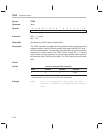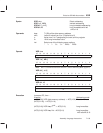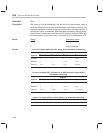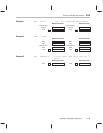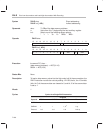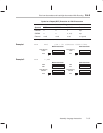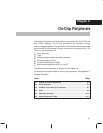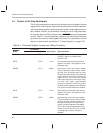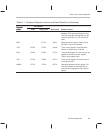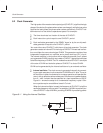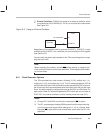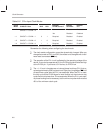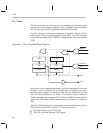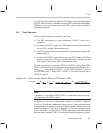
Control of On-Chip Peripherals
8-2
8.1 Control of On-Chip Peripherals
The on-chip peripherals are controlled by accessing control registers that are
mapped to on-chip I/O space. Data is also transferred to and from the peripher-
als through these registers. Setting and clearing bits in these registers can en-
able, disable, initialize, and dynamically reconfigure the on-chip peripherals.
On a device reset, the CPU sends an internal SRESET signal to the peripheral
circuits. Table 8–1 lists the peripheral registers and summarizes what hap-
pens when the values in these registers are reset. For a description of all the
effects of a device reset, see Section 5.7,
Reset Operation
, on page 5-33.
Table 8–1. Peripheral Register Locations and Reset Conditions
Register
I/O Address
Register
Name
’C209
Other ’C2xx Reset Value Effects at Reset
CLK
– FFE8h 0000h
CLKOUT1-pin control (CLK) register.
The
CLKOUT1 signal is available at the
CLKOUT1 pin.
SDTR – FFF0h xxxxh
Synchronous data transmit and receive
register.
The value in this register is unde-
fined after reset.
SSPCR – FFF1h 0030h
Synchronous serial port control register.
The port emulation mode is set to immedi-
ate stop. Error and status flags are reset.
Receive interrupts are set to occur when the
receive buffer is not empty. Transmit inter-
rupts are set to occur when the transmit
buffer can accept one or more words. Exter-
nal clock and frame synchronization
sources are selected. Continuous mode is
selected. Digital loopback mode is disabled.
The receiver and transmitter are enabled.
ADTR – FFF4h xxxxh
Asynchronous data transmit and receive
register.
The value in this register is unde-
fined after reset.
ASPCR
– FFF5h 0000h
Asynchronous serial port control register.
The port emulation mode is set to immedi-
ate stop. Receive, transmit, and delta in-
terrupts are disabled. One stop bit is se-
lected. Auto-baud alignment is disabled.
The TX pin is forced high between trans-
missions. I/O pins IO0, IO1, IO2, and IO3
are configured as inputs. The port is
disabled.



